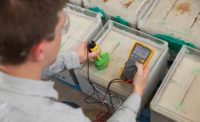
Andreas
Tselebidis
If not for a family trip to his parents’ native Greece in 1997, when he was a civil engineering student in Germany, concrete mix master Andreas Tselebidis would have missed his life’s calling.
When he returned at the end of the summer, all the thesis slots in structures had been filled. When someone suggested contacting Professor Hans Knoefel, known in Europe as the “Pope of Concrete,” Tselebidis hesitated. Knoefel was reputed to be a tough grader who hand-picked his students. Tselebidis decided to contact him anyway, rather than risk graduating a year late. Knoefel accepted him.
![]() In his thesis and PhD work, Tselebidis ended up proving the case for self-compacting concrete, which was not used in Europe at the time.
In his thesis and PhD work, Tselebidis ended up proving the case for self-compacting concrete, which was not used in Europe at the time.
“I got addicted to concrete like a drug user or an alcoholic,” says the director of sustainable concrete technology and solutions for chemical supplier BASF Corp. “I wanted to learn and understand all the reactions, from the nano to the macro scale.”
Tselebidis never did defend his dissertation on self-compacting concrete, largely because BASF scooped him up right out of school. He now is working on 59 projects around the globe, many of them top secret. One of his recent high-profile projects, which he calls his most challenging job ever, was Manhattan’s nearly complete, 1,397-ft-tall 432 Park Ave.
The 432 Park project was designed by Rafael Viñoly Architects to have an architecturally exposed, white-concrete exterior. “All the mix design constraints, taken together, had never been done before,” says Alex Ferrara, a general manager of ready-mix concrete producer Ferrara Bros.
Tselebidis made a difficult job much more manageable, colleagues note.
“Andreas is a brilliant concrete mind and knows all the details about the chemistry and physics of the material,” Ferrara explains.
Tselebidis’ current addiction is finding ways to improve concrete’s behavior, its energy storage potential and its structural qualities. “We can also further reduce its carbon footprint and turn it into a cozy and warm material,” he predicts.




Post a comment to this article
Report Abusive Comment